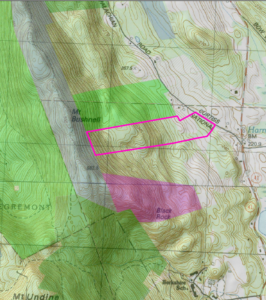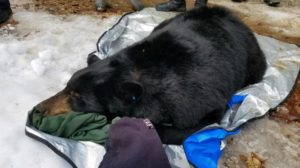At the March meeting of the Berkshire County League of Sportsmen, DFW Western District Supervisor, Andrew Madden, reported that MassWildlife recently acquired 70 acres of land in the town of Sheffield on Guilder Hollow Road. The property abuts the Dolomite Ledges Wildlife Management Area and contains open fields, steep cliff sides, and excellent habitat for deer, bear, turkey and other game species. Boundary marking and parking access will be completed this spring.
This and all other DFW wildlife management areas are open to the public for hunting, fishing, trapping and other passive recreation such as bird watching, hiking, etc.
Black bears relocated from dangerous area
Well, we knew that sooner or later the black bear population would be spreading into eastern Massachusetts. To get there quicker, it appears that they are taking to the highways. Did you hear about the mama bear and her two cubs that denned up on a highway median strip along Route 2 in Templeton? The following information was obtained from the MassWildlife web site:
On the morning of March 14, MassWildlife, with the help of transportation and law enforcement officials, closed Rte. 2 in the Templeton area for a short period of time to successfully immobilize and relocate a GPS-collared female black bear with two cubs from a wintering den site in the highway median strip.
Based on the GPS-collar data, MassWildlife biologists know the adult female went into this den site for the winter in November. She gave birth to her cubs some time in mid to late January. MassWildlife officials chose to relocate the bear family to a safer and more suitable location in a nearby wooded area to reduce the risk of vehicle collision when the cubs grow large enough to travel with their mother. The exact relocation site is not being disclosed to protect the safety of the young cubs at this particularly vulnerable phase of their lives. 
The adult female bear weighed 206 pounds; her two cubs (1 male and 1 female) each weighed a hefty 8+ pounds. The adult female is one of over thirty bears involved in a MassWildlife research project comparing differences between suburban-dwelling bears and bears residing in more rural areas. MassWildlife biologists are gathering data by collaring bears with radio telemetry and GPS-collars in the Berkshires, Connecticut River Valley, and Worcester County.
MassWildlife officials are reminding the public that March is the month when hungry bears emerge from their winter dens and seek out food. Natural foods such as acorns and other nuts are usually available on the ground, but last year’s fall hard mast crop was meager. Other seasonally available natural foods eaten by bears, such as skunk cabbage, are mostly ignored when there is an easy and more filling meal at backyard bird feeders, chicken coops, beehives, garbage cans, and dumpsters.
To prevent conflicts between people and bears, MassWildlife urges homeowners and food-related business in northern Middlesex County, Worcester County, western Massachusetts, or other areas where bears have been seen, to take down bird feeders and secure dumpsters and other waste containers. Beekeepers and poultry owners are advised to set up electric fencing as protection against marauding bears. For more information about black bears in Massachusetts and watch a video titled “Don’t Feed Bears, Keep Them Wild” visit mass.gov/bears.
Rocky Mountain Elk Foundation
From time to time, I am asked why this column promotes the local annual Rocky Mountain Elk Foundation (RMEF) banquets. They note that we don’t have any elk around here, and there aren’t that many local sportsmen who go out west to hunt elk.
Well, there are a surprising number of elk hunters in our area, but let’s consider the following: Just in the year 2018, the RMEF carried out 179 habitat enhancement projects benefitting 134,699 acres in 27 states and permanently protected 13,431 acres in 8 states. Since inception in 1984, the RMEF protected or enhanced 7.4 million acres, roughly 3 ½ times the size of Yellowstone National Park.
During 2018 it opened/improved access to 26,566 acres in 5 states. Since inception, it opened or improved 1.2 million acres, roughly 2 ½ times the size of the Great Smokey Mountains National Park.
That same year volunteers in 500+ chapters across 49 states raised record revenue for local and nationwide conservation missions. (fence pulls, construction of wildlife water developments, are among a few). In just that year, it provided $715,617 in funding to assist with 39 elk research projects and studies in 14 states plus 7 projects with national implications.
Since inception the total value of its work is estimated to be $1.1 billion. It has assisted with successful elk reintroductions in Kentucky, Missouri, North Carolina, Tennessee, Virginia, West Virginia and Ontario, Canada.
The local RMEF banquets are always very well attended. I suspect that most people who attend them will never hunt elk, but never-the-less they do feel good about doing something to increase elk habitat and help assure their survival.
Remembering George “Gige” Darey
Well, it’s been about 3 months since George “Gige” Darey of Lenox passed away. Readers may recall that he served 38 years on the MA Fish & Wildlife Board, 35 of which as its chairman. I’m not sure that all the accolades bestowed onto him fully covered his accomplishments while serving on that board. So, let’s take a look back and consider some of what he accomplished while serving on that board as recapped by F&W Board Vice Chairman Mike Roche:
• In 1978, when Gige took his seat on the Board, there were 4,000 acres of land protected by DFW. Today there are over 200,000.
• The deer harvest was 3,107. Last year it was over 13,000.
• Wild turkey was an experiment in 1978. Now the kill is over 3,000 a year.
• There were no nesting bald eagles in 1978. Since then 702 eagles have fledged with 68 nesting pairs last year.
• The pheasant program got to a point where it became self-sustainable.
• Regulations requiring the switch from lead shot to steel shot for waterfowl hunters were implemented.
• The Piping Plover was an endangered species back then, but now MA has most of the east coast piping plover population.
• The National Heritage Program was transferred from the Department of Environmental Management to MassWildlife in 1990 and the non-game check-off on tax forms was implemented.
• Gige urged the implementation of the “Presumption of Openness”. Now all land purchased in the Commonwealth is presumed to be open to hunting and fishing.
• There has been no license fee increase in over 20 years.
• He was heavily involved in the establishment of the Mass Outdoor Heritage Foundation, a non-profit (501c3). Those funds are used for such projects as wild brook trout restoration, and other worthy projects.
• Unlike many other states that allows Sunday hunting, he was able to obtain compensatory hunting dates for migratory bird hunting in Massachusetts.
• The Deer Management Zone system was implemented to improve opportunity for sportsmen.
• The Wildlands Stamp was established where sportsmen self-imposed a $5 assessment to the sale of hunting and fishing licenses. These funds were to be dedicated exclusively to the protection of wildlife habitat open to hunting, fishing, and other wildlife related recreation and science-based management of wildlife and wildlife habitat.
• A financial partnership with Ducks Unlimited for conservation efforts in Canada was established.
• A Memorandum of Understanding with the Environmental Police was established to increase resources and improve the outdoor education programs.
• Gige promoted the Archery-in-the-Schools program.
• He was Board Chairman when construction of the new DFW headquarters took place– one of the world’s finest and most environmentally progressive buildings.
• He fought hard to keep the DFW Director’s position from becoming a political appointment and keeping it in the hands of fish and wildlife professionals.
And, if I may add a few more that Roche did not mention:
• He fought for and finally obtained the Trout Catch & Release Sections in the Housatonic River in Lee and Stockbridge, and while at it, got the trout stocking program established which enhanced it. He accomplished the same for the Millers River.
• He was heavily involved in the environmental battle with GE for clean-up of Housatonic River.
• Gige was heavily involved with the ACEC (Area of Critical Environmental Concern) designation on the Housatonic River.
• Leveraging State and town funds, he played an important role with the Town of Lenox acquisition and conservation of the Post Farm, Parson’s Marsh and the Edith Wharton Park.
He accomplished a lot during that time period, ey?
